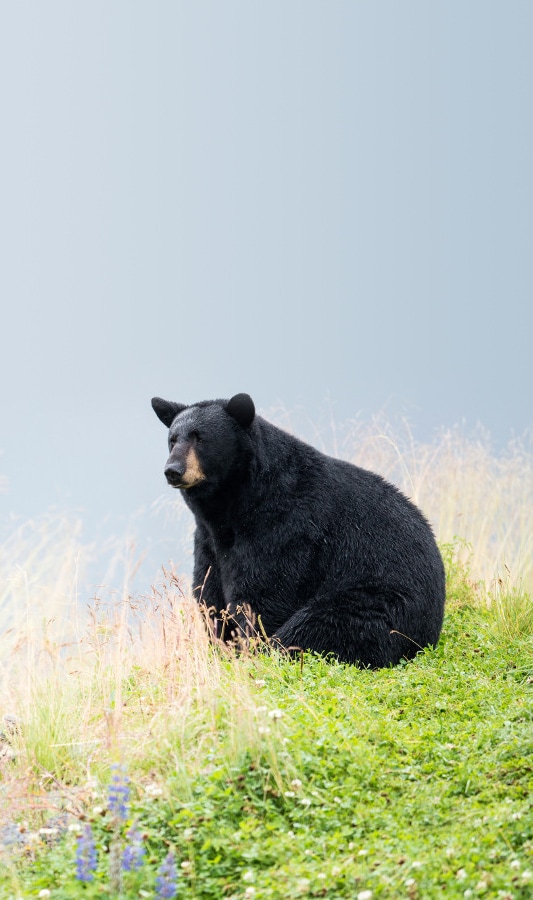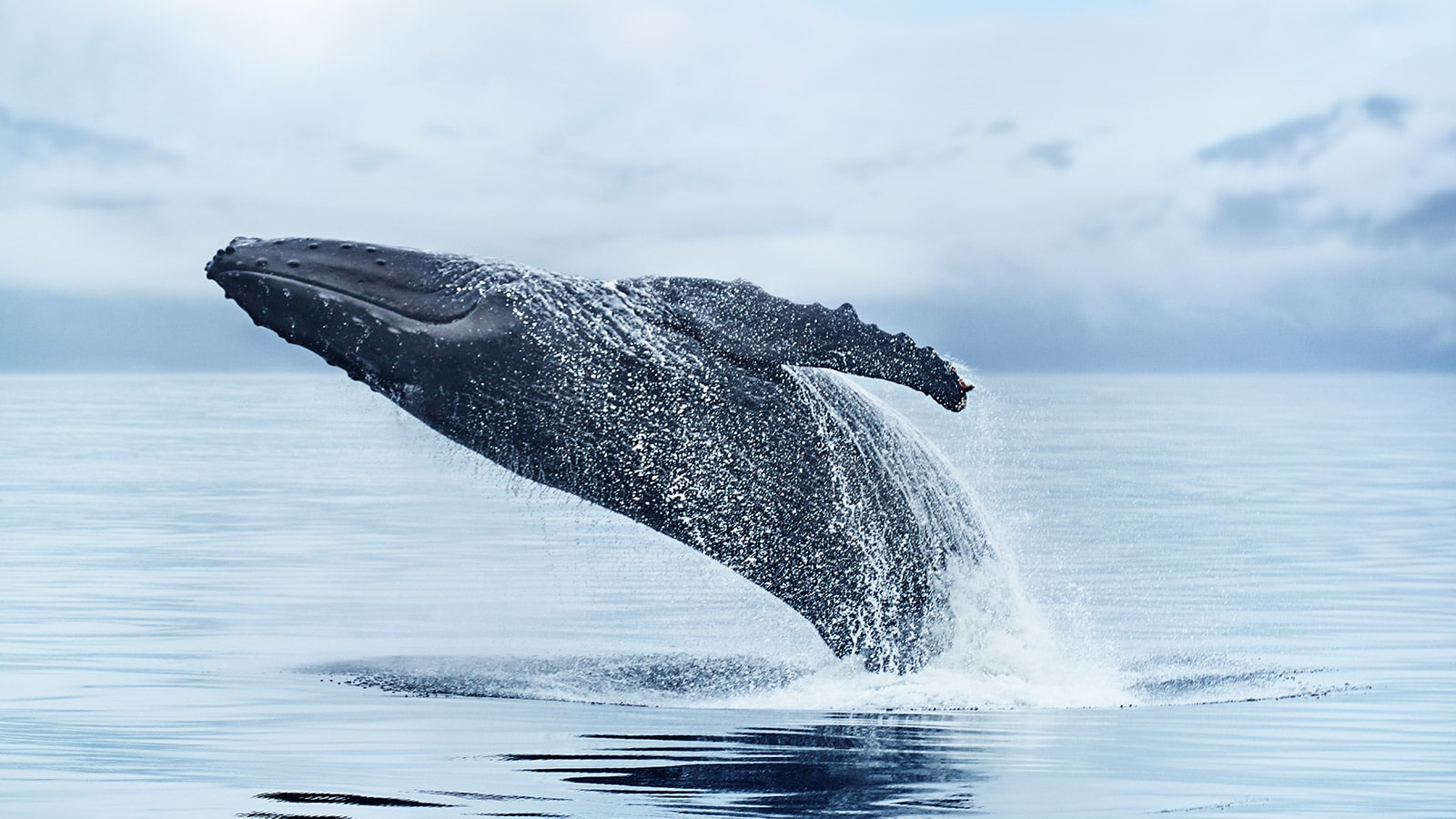Alaska wildlife includes some of the most amazing animals on the planet, making it a dream destination for anyone who appreciates nature. See otters floating through the water or orca whales surfacing from the sea. In Denali National Park, look for the Big Five — grizzly bears, wolves, moose, caribou and Dall sheep. Head into the depths of the Inside Passage for the chance to see hundreds of animals on an Alaska cruise.
In the summer, Alaska's waters are filled with more than 2,000 humpback whales that feed throughout Prince William Sound, Glacier Bay National Park and much of the Inside Passage in Southeast Alaska. Humpbacks are the most well-known — and sought-after — of Alaska's wildlife, with their massive 35-ton bodies gliding effortlessly through the waters feeding on thousands of pounds of small fish.
Contrary to their name, killer whales, also known as orcas, are members of the dolphin family. They are the largest, fastest and most powerful members of their kind. Not to mention, orcas are some of the most crowd-pleasing animals on an Alaska cruise. They receive the name "killer whale" due to their impressive hunting abilities, putting them at the top of Alaska's wildlife food chain.
Often seen lounging on the ice floes and bouncing on their bellies, harbor seals are one of the most famous Alaska animals. While not as limber on land, they make up for it with grace and speed in the water. In the summertime, almost two thousand harbor seals gather to hunt for fish, mate and raise their pups.
With strong front flippers and flexible rear flippers, sea lions can move their 600-2000-pound bodies faster than you’d imagine. Much like seals, their speed and maneuverability in the water are undeniably impressive, with the ability to dive more than 1,000 feet and hold their breath for over 15 minutes. Visitors can see and hear these adorable animals in Alaska during the summer as they gather to hunt and mate.
After near extinction, the sea otter remains one of the most recognized creatures of the ocean. You can often find these Alaska animals diving for shellfish or floating on their backs to eat. With up to one million hairs per inch — the most of any mammal — sea otters are comfortable in any climate. Look out for otters with lighter-colored fur around their faces. The lighter the color, the older the otter.
Salmon are the lifeblood of Alaska's ecosystem. Their annual return to the sea fills the rivers and feeds Alaska's animals, like bears and wolves. The local fishing industry relies on the plentiful harvest of salmon to provide for their economy and citizens. As world-famous celebrities, the native King Salmon attract locals and visitors to relish in what many call the best-tasting of their kind.
Alaska's wildlife includes both brown bears — often known as grizzlies — and black bears. Between the coastline, forests and hunting grounds, there is evidence of bears everywhere. Look for tracks across the beaches or trees rubbed clean of their bark. If you're lucky, you might even see bears themselves wandering the landscape in search of their next meal.
Standing at over six feet tall and weighing nearly as much as an automobile, moose are the largest of Alaska’s wildlife. Often found wandering the forests in search of fresh willow shoots, moose are solitary creatures that travel far and wide looking for nourishment. This frequently leads them into urban areas, along roads and in the path of everyday Alaskans, who have learned to live peacefully alongside them.
With both males and females being able to grow horns, herds of migrating caribou are a dramatic sight among the wildlife in Alaska. Most recognize caribou by another name — reindeer. But, in North America, that name is only given to domesticated caribou found across Alaska. Keep your eyes peeled for herds in search of food and their favorite calving grounds.
Covered in thick white fur, mountain goats live along the rocky cliffsides and mountain slopes of Alaska’s southern coastal region. Similar in appearance to Dall sheep, mountain goats can be easily distinguished by their black horns and thick fur as well as their ability to scale sheer cliffs at nearly a full run. Keep a lookout for these animals on your Alaska cruise.
Large curved horns, white fur and a stout body give Dall sheep the distinctive look of one of the toughest Alaska animals. Many recognize the dramatic clashes between males as they run full speed and crash their horned heads together. Yet, Dall sheep are rather peaceful animals. They live in the dry interior regions and wander mountainous areas in Kenai, Denali and Wrangell-St. Elias National Park.
Wolves roam much of the Great Land, traveling in small packs as they hunt for their favorite Alaska wildlife — caribou, moose and Dall sheep. While not typically seen in urban areas, wolves can be heard calling to each other from the distance. At up to three feet tall and over 100 pounds, these canines are slightly larger than your dog at home, and often work together to bring down moose that weigh over 1,000 pounds.
Arguably the most iconic bird in North America, the bald eagle lives throughout Alaska, Canada, the United States and northern Mexico. Alaska once held almost the entire population of the species when it was seriously endangered. Thanks to conservation efforts, bald eagles are now flourishing. Look for possible sightings of these Alaska animals along the coast and near rivers teeming with fish.
Puffins — both horned and tufted — live along the waters of Alaska, bringing their colorful plumage to the skies and sea. You can differentiate between the two by looking at their facial features. Tufted puffins have yellow feathers just above their eyes while horned puffins have black "horns" beneath them. While the tufted species is heavier than the horned, both Alaska animals are similar in size and wingspan.
The willow ptarmigan is the official state bird of Alaska and can be found in sparsely timbered or treeless areas. While visiting Denali National Park, you’re likely to see families of willow ptarmigan at streams along the length of the park road. This unique Alaska animal often changes with the season – donning a brown coat in the summer and a bright white fleece in the winter to hide from predators.

Animal Planet™ Partnership
Combining knowledge, insight and passion for exploration, we offer special excursions approved and recommended by the experts at Animal Planet™. When booking excursions, look for the corresponding mark to find immersive experiences and exclusive opportunities to meet Alaska’s wildlife and gain a fresh perspective on the places you travel.

Contribution to Wildlife Fund
In 2017, Princess® contributed $25,000 to the Alaska Wildlife Conservation Center from the Princess Animal Welfare Sponsor, a fund within the Princess Cruises Community Foundation. The sales of Stanley the Bear, named after Princess founder Stanley B. McDonald, helped to finance the expansion of AWCC facilities. The donation is also being used to build a bear-viewing area and interactive space to enrich visitor experiences.























